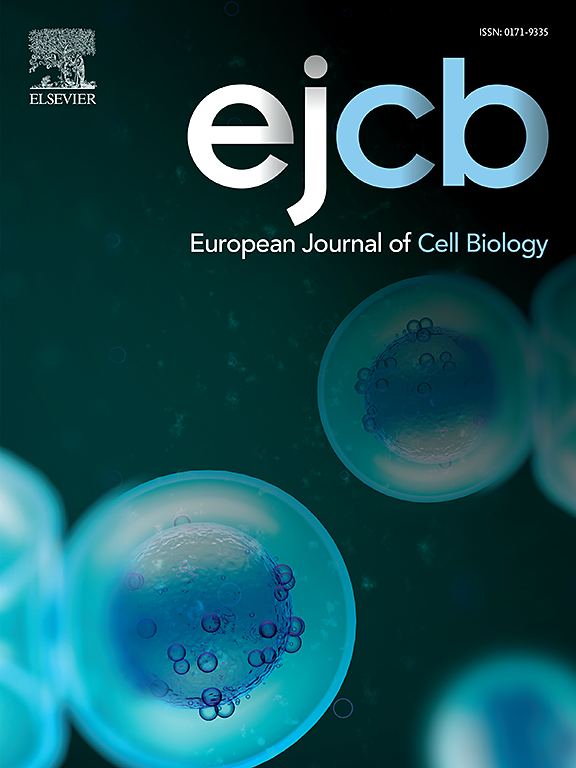Vitronectin regulates focal adhesion turnover and migration of human placenta-derived MSCs under nutrient stress
IF 4.3
3区 生物学
Q2 CELL BIOLOGY
引用次数: 0
Abstract
At sites of tissue damage and wound healing, the mesenchymal stem cells (MSCs) are often challenged by nutrient availability due to blood supply disruption. Thus, it becomes critical to identify novel factors and their mechanism of action in regulating the adhesion and migration of MSCs under nutrient stress condition for successful clinical application. In human placenta-derived MSCs (PL-MSCs), we demonstrated an increase in cell spread area, along with increased adhesion and reduced migration of the cells, when cultured under nutrient stress condition. Correspondingly, an increase in the total number per cell and size of focal adhesions (FAs), together with prominent stress fibers were observed in nutrient-stressed PL-MSCs compared to control PL-MSCs. The FAs were demonstrated to be more stable, exhibiting slower turnover and longer lifespan. Vitronectin (VTN), an ECM glycoprotein, was upregulated under nutrient stress condition. Knockdown of VTN in PL-MSCs led to a significant reduction in the total number per cell and size of FAs, along with their faster turnover and shorter lifespan. Subsequently, a reversal in the cell spread area, adhesion and migration properties of the nutrient-stressed PL-MSCs were noted. Additionally, our findings indicated that VTN, as an upstream regulator, stimulated the phosphorylation of myosin light chain, which possibly promoted the maturation and stability of FAs along with assembly of stress fibers, thereby leading to increased adhesion and reduced migration of the cells. Overall, our study defines a distinct role of VTN as a critical regulator of migration in PL-MSCs under nutrient stress condition.
Vitronectin调节人胎盘源间充质干细胞在营养胁迫下的黏附转换和迁移。
在组织损伤和伤口愈合的部位,由于血液供应中断,间充质干细胞(MSCs)经常受到营养可用性的挑战。因此,寻找营养胁迫条件下调节间充质干细胞粘附和迁移的新因素及其作用机制对临床成功应用至关重要。在人胎盘来源的MSCs (PL-MSCs)中,我们证明了在营养胁迫条件下培养时,细胞扩散面积增加,粘附性增加,细胞迁移减少。相应地,与对照PL-MSCs相比,营养胁迫PL-MSCs中每个细胞的总数和局灶黏附(FAs)的大小增加,以及突出的应激纤维。FAs被证明是更稳定的,表现出更慢的周转和更长的寿命。营养胁迫下ECM糖蛋白Vitronectin (VTN)表达上调。在PL-MSCs中,VTN的敲低导致FAs的每个细胞总数和大小的显著减少,以及它们更快的周转和更短的寿命。随后,注意到营养胁迫的PL-MSCs的细胞扩散面积,粘附和迁移特性的逆转。此外,我们的研究结果表明,VTN作为上游调节剂,刺激肌球蛋白轻链磷酸化,这可能促进FAs的成熟和稳定以及应力纤维的组装,从而导致细胞的粘附增加和迁移减少。总的来说,我们的研究明确了VTN作为营养胁迫条件下PL-MSCs迁移的关键调节因子的独特作用。
本文章由计算机程序翻译,如有差异,请以英文原文为准。
求助全文
约1分钟内获得全文
求助全文
来源期刊

European journal of cell biology
生物-细胞生物学
CiteScore
7.30
自引率
1.50%
发文量
80
审稿时长
38 days
期刊介绍:
The European Journal of Cell Biology, a journal of experimental cell investigation, publishes reviews, original articles and short communications on the structure, function and macromolecular organization of cells and cell components. Contributions focusing on cellular dynamics, motility and differentiation, particularly if related to cellular biochemistry, molecular biology, immunology, neurobiology, and developmental biology are encouraged. Manuscripts describing significant technical advances are also welcome. In addition, papers dealing with biomedical issues of general interest to cell biologists will be published. Contributions addressing cell biological problems in prokaryotes and plants are also welcome.
 求助内容:
求助内容: 应助结果提醒方式:
应助结果提醒方式:


